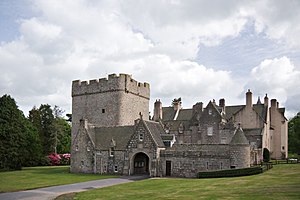Drum Castle
| Drum Castle | ||
|---|---|---|
|
Drum Castle |
||
| Creation time : | 13th Century | |
| Castle type : | Niederungsburg | |
| Conservation status: | Receive | |
| Standing position : | Gentry | |
| Geographical location | 57 ° 5 '42 " N , 2 ° 20' 16.8" W | |
|
|
||
Drum Castle is a castle near Drumoak in Aberdeenshire , Scotland . For centuries it was the seat of the Irvine clan . The place name "Drum" is derived from the Gaelic druim (dt. Elevation ).
The castle is owned by the National Trust for Scotland and is open to visitors during the summer. The chapel , dining room and property can be rented for weddings and corporate parties. A variety of local events such as classic car races and musical festivals take place here. There is a small shop and a tea room in the castle. Drum Castle's tower is considered to be the oldest residential tower in Scotland. The castle is surrounded by gardens from the 18th century, including a rose garden and an arboretum that contains trees from all regions of the British Empire from the 18th century. The castle also has a chapel built in the 15th century and extensively renovated in the 18th century.
history
The prehistoric settlement is known through archaeological sites such as Balbridie . Roman legions crossed the area on their campaign from Raedykes to nearby Normandykes . They used the Elsick Mounth , one of the oldest known roads that crossed the Grampian Mountains .
Drum Castle dates back to the 13th century and was built by the medieval builder Richard Cementarius , who also built the Bridge of Don in Old Aberdeen . The castle and its grounds were given to William de Irwyn by Robert the Bruce for faithful service in 1325 and remained in the possession of the Irvine clan until 1975 .
A large wing was added to the ninth laird in 1619 and other changes were made during the Victorian era .
Drum Castle played a role during the Covenanting Rebellion in which it was attacked and looted three times.
At the end of the 17th century, the family was forced to dispose of large parts of the land belonging to Drum Castle. However, the land directly surrounding the castle could be held.
In 1746, the Duke of Cumberland's government troops searched for the 17th Laird Alexander Irvine of Crimond after he had fought on the side of the insurgent Bonnie Prince Charlie . Alexander fled to his parents' Drum Castle, where he was hidden in a secret room by his sister Mary. Allegedly, Alexander spent three full years in the hiding place while he prepared his escape.
In 1991 the National Trust for Scotland created a rose garden, the Garden Of Historic Roses .
In 2013, archaeologist Jonathan Clark examined the castle on behalf of the National Trust for Scotland, to which the castle now belongs. He discovered two rooms that had been walled up in the 1840s. According to speculation, these could be the rooms in which Alexander Irvine was hiding in the middle of the 18th century.
Footnotes
- ↑ Drum Castle at National Trust website ( Memento of the original from June 25, 2007 in the Internet Archive ) Info: The archive link was automatically inserted and not yet checked. Please check the original and archive link according to the instructions and then remove this notice.
- ↑ a b c Angelika Franz: The secret room of Drum Castle. In: Spiegel Online . July 14, 2013. Retrieved July 14, 2013 .
- ↑ a b c Drum Castle. In: schottland-wegweiser.de. Retrieved July 14, 2013 .
- ↑ C. Michael Hogan: Elsick Mounth. Megalithic Portal, Ed. A. Burnham
Web links
- Drum Castle as a 3D model in SketchUp's 3D warehouse

